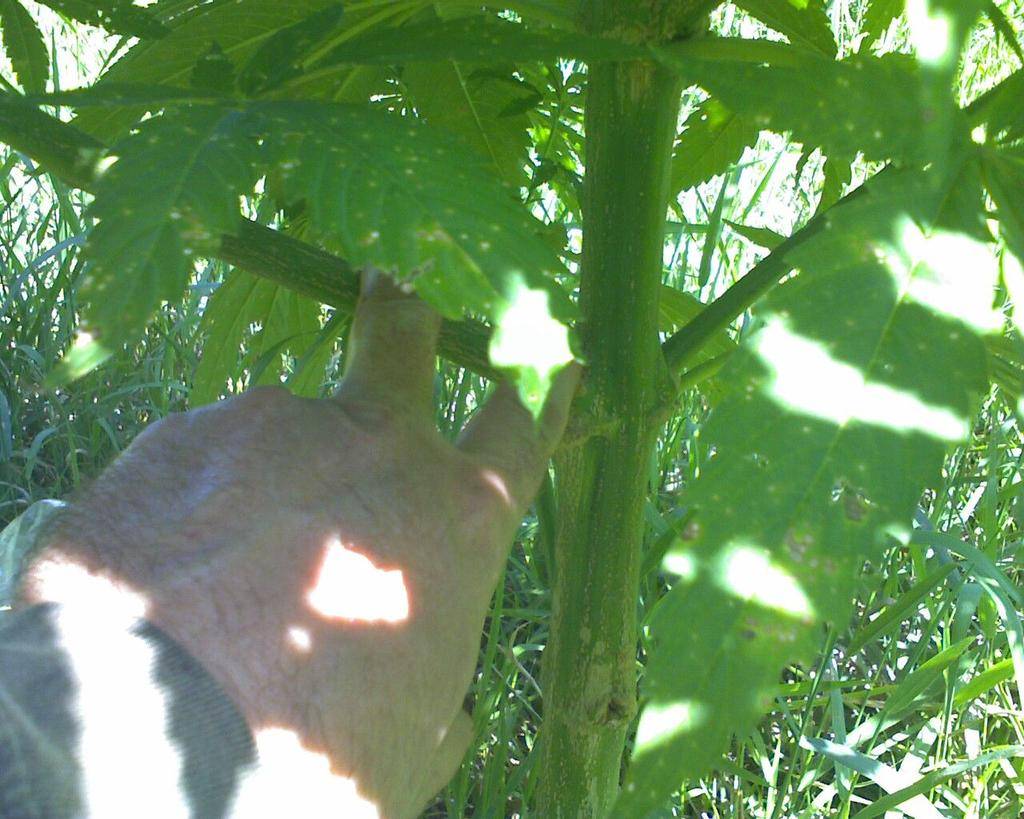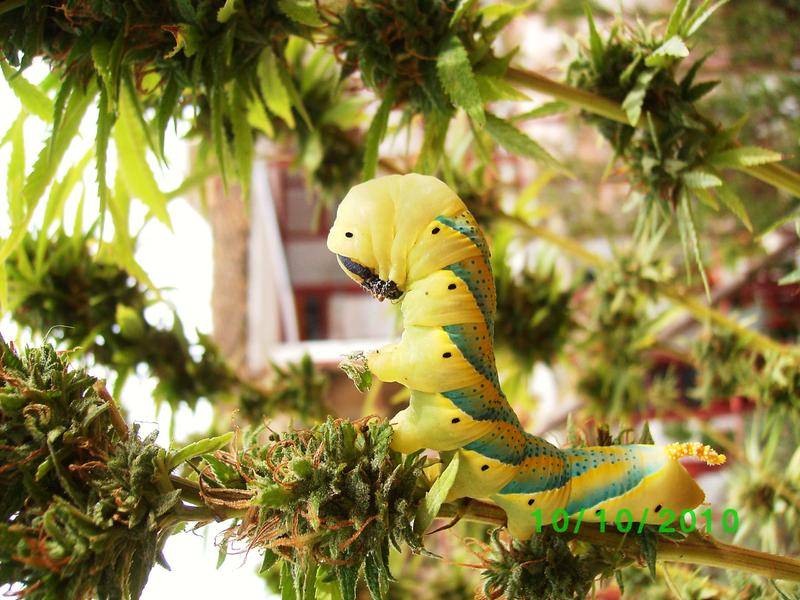-
ICMag with help from Phlizon, Landrace Warden and The Vault is running a NEW contest for Christmas! You can check it here. Prizes are: full spectrum led light, seeds & forum premium access. Come join in!
You are using an out of date browser. It may not display this or other websites correctly.
You should upgrade or use an alternative browser.
You should upgrade or use an alternative browser.
Outdoor Strainguide-Please contribute!
- Thread starter BACKCOUNTRY
- Start date
xevinieto8
New member
hahaha yeeah I agree!!
BlueBonic x GG
BlueBonic x GG
Strain: BlueBonic X GG
Breeder: krk @UDG
Harvest date: Sept20th - Oct 1st
Mold: None - 2%
Potency: 6.5-7 out of 10
Yield: 3/4lb per plant
This is yet another hybrid from the breeders at UDG it is a very robust plant with rebar like branches that will hold all the weight they produce. Big yields are no good if its hanging all over the ground full of mold and I want to highlight that fact the structure of this plant is amazing and will withstand wind, rain and heavy bud production.
Sorry no bud pics but this plant produces tight nugs with very little stem that gives it great bag appeal. It seems to be almost mold proof and the only mold i saw was from a branch that was lying on the ground. The Sept 20th pheno is light green in color with a minty/piney flavor seems to be what people like but the Oct 1st phenos start to change colors with bud colors of gold and purple and a fruity smell. A very slight blueberry taste that maybe with a cure the flavor would be more pronounced. I recommend it to anyone looking for big yields, bulletproof plants with a great structure.
I started these plants around June 7th - 10th and ended up with around eight 5-6 ft tall bushes (not topped) and the average with a couple of runts was 3/4lb per plant.


BlueBonic x GG
Strain: BlueBonic X GG
Breeder: krk @UDG
Harvest date: Sept20th - Oct 1st
Mold: None - 2%
Potency: 6.5-7 out of 10
Yield: 3/4lb per plant
This is yet another hybrid from the breeders at UDG it is a very robust plant with rebar like branches that will hold all the weight they produce. Big yields are no good if its hanging all over the ground full of mold and I want to highlight that fact the structure of this plant is amazing and will withstand wind, rain and heavy bud production.
Sorry no bud pics but this plant produces tight nugs with very little stem that gives it great bag appeal. It seems to be almost mold proof and the only mold i saw was from a branch that was lying on the ground. The Sept 20th pheno is light green in color with a minty/piney flavor seems to be what people like but the Oct 1st phenos start to change colors with bud colors of gold and purple and a fruity smell. A very slight blueberry taste that maybe with a cure the flavor would be more pronounced. I recommend it to anyone looking for big yields, bulletproof plants with a great structure.
I started these plants around June 7th - 10th and ended up with around eight 5-6 ft tall bushes (not topped) and the average with a couple of runts was 3/4lb per plant.
Strain/Breeder: Frisian Dew (Dutch Passion)
Harvest time: End Sept
Latitude of grow: 48° N
Average yield: yield was very variable; the cutting ones were biggest; no green pheno;
Mold?: no mold
Potency: 6,5/10
Grower notes: I think the price (42€ - 5fem.) is far too high u even get equally good strains with lower prices; the best plants were those which we cut (as u see on the pic); the two reasons why I would grow her again: 1) ready in sept. 2) no mold
Harvest time: End Sept
Latitude of grow: 48° N
Average yield: yield was very variable; the cutting ones were biggest; no green pheno;
Mold?: no mold
Potency: 6,5/10
Grower notes: I think the price (42€ - 5fem.) is far too high u even get equally good strains with lower prices; the best plants were those which we cut (as u see on the pic); the two reasons why I would grow her again: 1) ready in sept. 2) no mold
Attachments
silentsmoke
New member
thanks for all the info!!! couldnt do it without the help
hi does anyone have any recommendations for a newbie at 53 degrees north in alberta canada?
i've been thinking of guerrilla gold or a cross or maybe leb27 but i'm kinda clueless thus far and would appreciate any tips
i've been thinking of guerrilla gold or a cross or maybe leb27 but i'm kinda clueless thus far and would appreciate any tips
Marco32
Member
i've been thinking of guerrilla gold or a cross or maybe leb27 but i'm kinda clueless thus far and would appreciate any tips
You're thinking along the right lines Jesse, also look in to Danish genetics as they're at a similar latitude as you and grow some impressively early strains ..

Hi!!!!!!!!! Look my wonderful pet!! We arent the only who loves weed ( Humans)!!! This is a Death's-head Hawkmoth, "Acherontia atropos". Acherontia atropos is the most widely-known of the three species of Death's-head Hawkmoth. Found throughout the Middle East and the Mediterranean region, and increasingly as far north as southern Great Britain due to recently mild British winters, this moth is easily distinguishable from others in this region by a vaguely skull-shaped pattern on its thorax. A. atropos is also very large, with a wingspan of 90–130 mm (three to five inches), being the largest moth in some of the regions in which it is found. The adult has the typical streamlined wings and body of Sphingidae. The upper wings are brown with slight yellow wavy lines; the lower wings are yellow with some wide brown waves. It rests during the day on trees or in the litter, holding the wings like a tent over the body.
The moth also has numerous other unusual features. It has the ability to emit a loud squeak if irritated. The sound is produced by expelling air from its proboscis. It often accompanies this sound with flashing its brightly marked abdomen in a further attempt to deter its predators. It is commonly observed raiding beehives for honey at night. Unlike the other species of Acherontia, it only attacks colonies of the well-known Western honey bee, Apis mellifera. It is attacked by guard bees at the entrance, but the thick cuticle and resistance to venom allow it to enter the hive. It is able to move about in hives unmolested because it mimics the scent of the bees.[1]
The British entomological journal Atropos takes its name from this species.
What an amazing looking creature!
Looks similar to the one in alice in wonderland
Attachments
Thai_Fighter
New member
Hi!!!!!!!!! Look my wonderful pet!! We arent the only who loves weed ( Humans)!!! This is a Death's-head Hawkmoth, "Acherontia atropos". Acherontia atropos is the most widely-known of the three species of Death's-head Hawkmoth. Found throughout the Middle East and the Mediterranean region, and increasingly as far north as southern Great Britain due to recently mild British winters, this moth is easily distinguishable from others in this region by a vaguely skull-shaped pattern on its thorax. A. atropos is also very large, with a wingspan of 90–130 mm (three to five inches), being the largest moth in some of the regions in which it is found. The adult has the typical streamlined wings and body of Sphingidae. The upper wings are brown with slight yellow wavy lines; the lower wings are yellow with some wide brown waves. It rests during the day on trees or in the litter, holding the wings like a tent over the body.
The moth also has numerous other unusual features. It has the ability to emit a loud squeak if irritated. The sound is produced by expelling air from its proboscis. It often accompanies this sound with flashing its brightly marked abdomen in a further attempt to deter its predators. It is commonly observed raiding beehives for honey at night. Unlike the other species of Acherontia, it only attacks colonies of the well-known Western honey bee, Apis mellifera. It is attacked by guard bees at the entrance, but the thick cuticle and resistance to venom allow it to enter the hive. It is able to move about in hives unmolested because it mimics the scent of the bees.[1]
The British entomological journal Atropos takes its name from this species.
F.A.N.T.A.S.T.I.C.


VoDvaR
Member
Hello, I found some old photos so I decided to share it with you.
Strain/Breeder: Shaman / Dutch Passion regular
Harvest time: at end of September
Latitude of grow: 48°N
Location: central Europe
Yield: medium
Mold: no
Potency: 5/10
Year of grow: 2007



Strain/Breeder: Holland's Hope / Dutch Passion regular
Harvest time: middle of October
Latitude of grow: 48°N
Location: central Europe
Yield: medium
Mold: minimum
Potency: 7/10
Year of grow: 2007



Strain/Breeder: Swiss Crypto / clone
Harvest time: middle of October
Latitude of grow: 48°N
Location: central Europe
Yield: medium
Mold: minimum
Potency: 9/10
Year of grow: 2007



Strain/Breeder: Heaven / clone
Harvest time: middle of October
Latitude of grow: 48°N
Location: central Europe
Yield: medium
Mold: no
Potency: 8/10
Year of grow: 2007




Strain/Breeder: Shaman / Dutch Passion regular
Harvest time: at end of September
Latitude of grow: 48°N
Location: central Europe
Yield: medium
Mold: no
Potency: 5/10
Year of grow: 2007
Strain/Breeder: Holland's Hope / Dutch Passion regular
Harvest time: middle of October
Latitude of grow: 48°N
Location: central Europe
Yield: medium
Mold: minimum
Potency: 7/10
Year of grow: 2007
Strain/Breeder: Swiss Crypto / clone
Harvest time: middle of October
Latitude of grow: 48°N
Location: central Europe
Yield: medium
Mold: minimum
Potency: 9/10
Year of grow: 2007
Strain/Breeder: Heaven / clone
Harvest time: middle of October
Latitude of grow: 48°N
Location: central Europe
Yield: medium
Mold: no
Potency: 8/10
Year of grow: 2007
VoDvaR
Member
Strain/Breeder: Voodoo / Dutch Passion regular
Harvest time: at end of September
Latitude of grow: 48°N
Location: central Europe
Yield: medium
Mold: no
Potency: 4/10
Year of grow: 2009



Strain/Breeder: Durban Poison / Dutch Passion regular
Harvest time: early October
Latitude of grow: 48°N
Location: central Europe
Yield: medium
Mold: little more
Potency: 5/10
Year of grow: 2009


Strain/Breeder: Moutain Jam / clone
Harvest time: middle of October
Latitude of grow: 48°N
Location: central Europe
Yield: big
Mold: no
Potency: 9/10
Year of grow: 2009



Strain/Breeder: Cheese / clone
Harvest time: at end of October
Latitude of grow: 48°N
Location: central Europe
Yield: medium
Mold: no
Potency: 8/10
Year of grow: 2009

Harvest time: at end of September
Latitude of grow: 48°N
Location: central Europe
Yield: medium
Mold: no
Potency: 4/10
Year of grow: 2009
Strain/Breeder: Durban Poison / Dutch Passion regular
Harvest time: early October
Latitude of grow: 48°N
Location: central Europe
Yield: medium
Mold: little more
Potency: 5/10
Year of grow: 2009
Strain/Breeder: Moutain Jam / clone
Harvest time: middle of October
Latitude of grow: 48°N
Location: central Europe
Yield: big
Mold: no
Potency: 9/10
Year of grow: 2009
Strain/Breeder: Cheese / clone
Harvest time: at end of October
Latitude of grow: 48°N
Location: central Europe
Yield: medium
Mold: no
Potency: 8/10
Year of grow: 2009
VoDvaR
Member
Strain/Breeder: Double Gum (Diamond) / clone
Harvest time: early October
Latitude of grow: 48°N
Location: central Europe
Yield: low/medium
Mold: no
Potency: 8/10
Year of grow: 2010


Strain/Breeder: Alpine Rocket / clone
Harvest time: early October
Latitude of grow: 48°N
Location: central Europe
Yield: low/medium
Mold: no
Potency: 8/10
Year of grow: 2010


Strain/Breeder: Pamir Gold / Dutch Passion feminized (different pheno from other)
Harvest time: middle/end of October
Latitude of grow: 48°N
Location: central Europe
Yield: low/medium
Mold: no
Potency: 7/10
Year of grow: 2010



Strain/Breeder: Voodoo / Dutch Passion feminized
Harvest time: middle/end of October
Latitude of grow: 48°N
Location: central Europe
Yield: low/medium
Mold: no
Potency: 3/10
Year of grow: 2010

Strain/Breeder: Durban Poison / Dutch Passion feminized
Harvest time: middle/end of October
Latitude of grow: 48°N
Location: central Europe
Yield: low/medium
Mold: no
Potency: 4/10
Year of grow: 2010


Strain/Breeder: Holland's Hope / Dutch Passion feminized
Harvest time: middle/end of October
Latitude of grow: 48°N
Location: central Europe
Yield: low
Mold: no
Potency: 2/10
Year of grow: 2010


Strain/Breeder: Pamir Gold / Dutch Passion feminized
Harvest time: early October
Latitude of grow: 48°N
Location: central Europe
Yield: big
Mold: no
Potency: 8/10
Year of grow: 2010



Harvest time: early October
Latitude of grow: 48°N
Location: central Europe
Yield: low/medium
Mold: no
Potency: 8/10
Year of grow: 2010
Strain/Breeder: Alpine Rocket / clone
Harvest time: early October
Latitude of grow: 48°N
Location: central Europe
Yield: low/medium
Mold: no
Potency: 8/10
Year of grow: 2010
Strain/Breeder: Pamir Gold / Dutch Passion feminized (different pheno from other)
Harvest time: middle/end of October
Latitude of grow: 48°N
Location: central Europe
Yield: low/medium
Mold: no
Potency: 7/10
Year of grow: 2010
Strain/Breeder: Voodoo / Dutch Passion feminized
Harvest time: middle/end of October
Latitude of grow: 48°N
Location: central Europe
Yield: low/medium
Mold: no
Potency: 3/10
Year of grow: 2010
Strain/Breeder: Durban Poison / Dutch Passion feminized
Harvest time: middle/end of October
Latitude of grow: 48°N
Location: central Europe
Yield: low/medium
Mold: no
Potency: 4/10
Year of grow: 2010
Strain/Breeder: Holland's Hope / Dutch Passion feminized
Harvest time: middle/end of October
Latitude of grow: 48°N
Location: central Europe
Yield: low
Mold: no
Potency: 2/10
Year of grow: 2010
Strain/Breeder: Pamir Gold / Dutch Passion feminized
Harvest time: early October
Latitude of grow: 48°N
Location: central Europe
Yield: big
Mold: no
Potency: 8/10
Year of grow: 2010
Strain/Breeder: MMGGxBHPT / vod
(manitoba medicine x guerilla gold) x (bangi haze x purpurea ticinensis)
Harvest time: 15 October
Latitude of grow: 52°N
Location: Poland
Yield: medium
Mold: 15%
Potency: 9/10
Year of grow: 2010
One of the best outdoor weed I ever smoke. The most potent weed in my 2010 garden...and the earliest chopped But high is definitely not im looking for. Indica stoned effect. One plant was pollinated by Orange Bud f3. Grown in 11 liter pot. Here's some photos:
But high is definitely not im looking for. Indica stoned effect. One plant was pollinated by Orange Bud f3. Grown in 11 liter pot. Here's some photos:

















Peace
Padkontrol
(manitoba medicine x guerilla gold) x (bangi haze x purpurea ticinensis)
Harvest time: 15 October
Latitude of grow: 52°N
Location: Poland
Yield: medium
Mold: 15%
Potency: 9/10
Year of grow: 2010
One of the best outdoor weed I ever smoke. The most potent weed in my 2010 garden...and the earliest chopped
Peace
Padkontrol

G
guest8905
that Pamir gold 2nd pheno is really nice looking
Strain/Breeder: Lebanese, Bluehemp
Harvest time: Late September
Latitude of grow: 52N
Location: U.K
Average yield:
Mold?: Good mold resistance, but be careful of the grey one.
Potency: 8/10
Year of grow: 2008 + 2009
All round nice Indica some will go purple all have a blue/purfumey/sandlewood smell/taste.
The only thing to watch out for with this strain is it has a sativa pheno, I would guess 1/5 plants will be the sat pheno which takes a month longer to finish and has wispy buds about half the potency.
Harvest time: Late September
Latitude of grow: 52N
Location: U.K
Average yield:
Mold?: Good mold resistance, but be careful of the grey one.
Potency: 8/10
Year of grow: 2008 + 2009
All round nice Indica some will go purple all have a blue/purfumey/sandlewood smell/taste.
The only thing to watch out for with this strain is it has a sativa pheno, I would guess 1/5 plants will be the sat pheno which takes a month longer to finish and has wispy buds about half the potency.
Attachments
Strain/Breeder: Double Afghan Slam, Reeferman.
Harvest time: Late September
Latitude of grow: 52N
Location: U.K
Average yield: V. Good
Mold?: Hardly any, v. good mold resistance
Potency: 9/10
Year of grow:
2 distinct pheno a tall and a short column type, both 100% indica bushes fat robust and earthy.
Incredible perfumey buds just like in the catalogue description.
A few tokes and this afghan is slammin your brain.
Harvest time: Late September
Latitude of grow: 52N
Location: U.K
Average yield: V. Good
Mold?: Hardly any, v. good mold resistance
Potency: 9/10
Year of grow:
2 distinct pheno a tall and a short column type, both 100% indica bushes fat robust and earthy.
Incredible perfumey buds just like in the catalogue description.
A few tokes and this afghan is slammin your brain.
Attachments
Strain/Breeder: Purple Peace, Green Ambassador
Harvest time: Late September
Latitude of grow: 50N
Location: U.K
Average yield: Excellent
Mold?: Wispy buds = Minimal mold
Potency: 7/10
Year of grow:
Beast of a strain, mine grew like a 90% sativa, huge christmas tree bush with wispy lavender buds.
Even though the buds are airy, shes a big yeilder when grown in the ground.
Mild up high, spicy taste not as rich as the afghan strains but v nice.
Highly recomended if you want a sativa high early outdoors.
Harvest time: Late September
Latitude of grow: 50N
Location: U.K
Average yield: Excellent
Mold?: Wispy buds = Minimal mold
Potency: 7/10
Year of grow:
Beast of a strain, mine grew like a 90% sativa, huge christmas tree bush with wispy lavender buds.
Even though the buds are airy, shes a big yeilder when grown in the ground.
Mild up high, spicy taste not as rich as the afghan strains but v nice.
Highly recomended if you want a sativa high early outdoors.
Attachments
Strain/Breeder: Ethiopian Highland, African seeds
Harvest time: Mid November +
Latitude of grow: 50N
Location: U.K
Average yield: Good
Mold?: Excellent
Potency: 6/10
Year of grow:
Pure Sativa landrace.
Not reccomended as a reliable northern outdoor strain, will not go to its full potential in our climate, but it will make nice buds by november, its earlier than thai and a little earlier than malawi.
If you want to try something different and like taking risks then go for it, small sweet buds that benefit alot from a 3 month + cure.
Subtle high relaxing enough to sleep on but very alert mentally.
These tropical strains are actually lethal when grown properly under tropical sun and cured for 6 months +
This is because they need intense sunlight to activate their resin fully.
Harvest time: Mid November +
Latitude of grow: 50N
Location: U.K
Average yield: Good
Mold?: Excellent
Potency: 6/10
Year of grow:
Pure Sativa landrace.
Not reccomended as a reliable northern outdoor strain, will not go to its full potential in our climate, but it will make nice buds by november, its earlier than thai and a little earlier than malawi.
If you want to try something different and like taking risks then go for it, small sweet buds that benefit alot from a 3 month + cure.
Subtle high relaxing enough to sleep on but very alert mentally.
These tropical strains are actually lethal when grown properly under tropical sun and cured for 6 months +
This is because they need intense sunlight to activate their resin fully.









